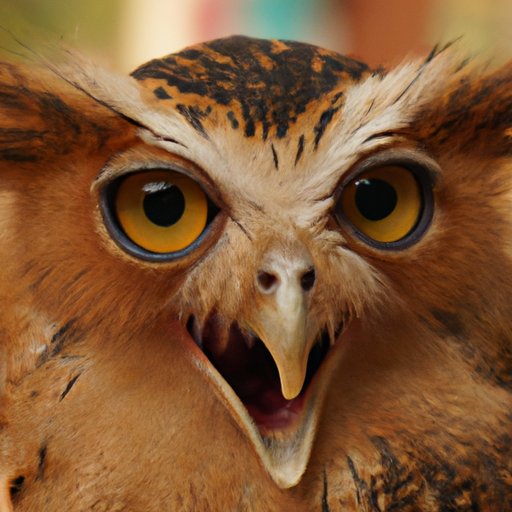Introduction
If you’ve ever been out in the woods or even just taking a nighttime stroll, you may have heard the distinct sounds of an owl’s hoot. For some, their hoots can be eerie, especially at night. For others, it’s a curious moment to wonder why they hoot in the first place. In this article, we will explore the various reasons why owls hoot, debunk some common myths and misconceptions, and uncover some surprising facts about these magnificent creatures.
How Owls Communicate: The Reason Behind Their Hoots
Owls communicate through sound, especially at night. The primary purpose of their hoots is to identify themselves and other owls, attract mates, establish territories, and warn off potential predators. Each owl species varies in the sounds they make, from screeches to whistles to barks, but they all serve the same purpose.
One particular fascinating aspect of owl communication is they use both simple and complicated calls, especially for courtship. Owls like to “duet,” contributing to variations and nuances in their complex vocalizations. By communicating, owls help offspring learn calls, navigate territory, regulate population density, locate prey, and understand the social environment.
The Mystery of the Owl’s Hoot: Exploring the Many Theories
There are many popular theories about why owls hoot, some more scientific than others. Some suggest that hooting predicts the weather, while others believe it relates to territorial behavior, communication between owls, or reproductive signals.
One of the most common theories behind their hooting activity is to establish territory. Owls use different variations of hoots across many species to let other owls know about their hunting territory. Hooting can be used as a warning system to warn other owls that they are intruding on their hunting ground. However, some owl species migrate in winter, so territory might not be a significant factor for some species.
Another theory is that owls hoot to find a mate, and can even use chanting vocalizations to attract a mate. This theory may have some basis given the elaborate duets that some species perform during mating season.
Regardless of these theories, it is important to note that each owl species has unique hooting patterns. There may be some overlap, but each owl’s hoot might function differently than other species.
The Surprising Facts You Didn’t Know About Why Owls Hoot
Owls possess some surprising abilities with their hooting. They can adjust their hoot volume and pitch to their mood or environment. Their hearing capabilities are so incredible that they locate prey by honing in on the slightest variations in sound. Also, owls have asymmetrical ear positions to provide them with hearing advantages. Their right ear is higher than the left, so they can triangulate on the location of their prey.
One interesting fact is that owls are using ultrasonic whispers to locate prey, which is undetectable to the human brain. Therefore, owls use two types of sounds, from deep-toned hoots to high-pitched ultrasonic whispers, to help determine the location of their prey.
Another critical factor is how human activity and noise pollution can interfere with owl communication and behavior, just like other wildlife. Noise pollution from trains, planes, and other human activities can affect how well owls communicate with each other, and it can cause their behavior to shift. Researchers conducting studies have shown that the sound from wind turbines has the potential to harm owls’ hearing extensively.
A Closer Look at the Different Types of Owl Hoots and Their Meanings
Owls hoot in different tones and patterns depending on their species or the message they want to convey. Many species engage in duets or develop unique vocalizations that help identify themselves, coordinate with their mate, or serve as a warning to potential predators.
Some hoots are simple notes, whereas others range from long and lilting to harsh and choppy. Some species of owl might hoot in a more musical tone, while others tend to have more eerie types of calls.
For example, the great horned owl has a deep and relatively low-pitched hoot, while the screech owl has a high-pitched piercing hoot. The barred owl has a range of vocalizations, including a low-pitched “who cooks for you” to another range of sounds like barks, whistles and screams that it uses to communicate with each other.
Owls and Their Hoots: Revealing the Relationship Between Sound and Survival
Owl communication and their use of hooting plays an essential role in owl survival. Owls use vocalizations to control their population sizes in much the same way that other animals use their vocalizations. Hooting also helps them coordinate their locations within their territories and commuicate the location of predators.
At the moment, many owl species are facing declining populations due to habitat destruction, and this directly affects their sound-based communication. As we humans continue to develop and disrupt owl habitats, we also affect their food chain, which ultimately causes a complete disruption of the ecosystem.
Conclusion
Owls are majestic creatures that have survived for hundreds of years due to their robust vocalizations, especially their hooting. The unique sounds and distinct patterns of hoots have helped these nocturnal birds of prey to navigate their environments, coordinate with their mates, and send warning signals to predators. Understanding the various theories around the hoots of owls can help us appreciate the complexities of these birds and better coexist in the natural world with them.
